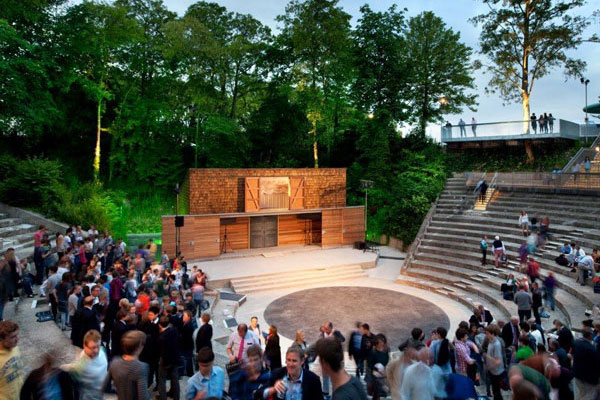Indesignlive stops by Clerkenwell Design Week in London to speak with Maigrau, a small design studio fusing German classicism with contemporary views.
June 13th, 2012
Emerging designers in Germany have a tough task ahead of them. It’s a country known for its cars and technology – think BMW, Mercedes-Benz, Siemens, etcetera – while its well-known furniture designs fade into the relative obscurity of the ’classics’.
But there’s a new energy coming from the country’s young design studios, and some are going out on their own.
One such company is Maigrau, a small design brand with a collective approach.

“Maigrau is not a design studio in the classical sense, which works for other brands,” explains Alexander Stamminger, Managing Director for Maigrau.
“We understand ourselves as a furniture brand with a collection comprising furniture, lighting and home accessories. Some of our products are designed in-house and some of them are designed by external designers.”
Having studied together at Stuttgart State Academy of Art and Design, Stamminger and partner Nick Back began Maigrau in 2008, with an aim to create products with a clear language, rooted in the “logic of their functionality and materials” (delightfully German).

The duo has a commitment to local manufacturing that harmonises with their environmental approach. But for them, sustainability is not the only motivator for German production.
“The label ’Made in Germany’ is historically grown and still stands for quality and stability of value,” Stamminger says.
“Many German manufacturers are remembering these values and have brought parts of their fabrication back to Germany. In many cases it is easier and cheaper for us to communicate with German manufacturers, and when the offered quality comes up to our requirements why should we look for manufacturers in foreign countries?”

Maigrau recently made their UK debut at Clerkenwell Design Week in London, presenting their latest collection.

“For us [Clerkenwell Design Week] offers opportunities; it’s very inspiring to get in contact with other creative folks from all over the world and see how our products are experienced by other people. Their view on our products is an important tool for us to improve our designs or to put new designs to the test.
“Apart from this we regard it as an important opportunity to get in contact with local dealers, architects and press. That’s the premise to establish in a new market like the UK.”

Without a long history of design woven into the fabric of German society, it’s often difficult for us to understand the pressure, and the opportunities, that such a culture can bring.
The exciting prospect of new brands – not just new designers – emerging from Germany is that, not only are they determined to continue a tradition of craftsmanship, quality and functionality, but they are determined to make a name for themselves as the ’new wave of German design’.
Let’s hope Maigrau is the first of many, and will soon widen their network to also encompass Australia.
Maigrau
maigrau.com
A searchable and comprehensive guide for specifying leading products and their suppliers
Keep up to date with the latest and greatest from our industry BFF's!

XTRA celebrates the distinctive and unexpected work of Magis in their Singapore showroom.

In this candid interview, the culinary mastermind behind Singapore’s Nouri and Appetite talks about food as an act of human connection that transcends borders and accolades, the crucial role of technology in preserving its unifying power, and finding a kindred spirit in Gaggenau’s reverence for tradition and relentless pursuit of innovation.

Within the intimate confines of compact living, where space is at a premium, efficiency is critical and dining out often trumps home cooking, Gaggenau’s 400 Series Culinary Drawer proves that limited space can, in fact, unlock unlimited culinary possibilities.

Architects Studio Octopi were appointed to undertake the modernisation and reinvention of Bradfield College’s 1890 amphitheatre. Words by Justin Farmer.

Solari Architects has recently relocated to 191 Cuba Street, joining the Victoria University of Wellington’s School of Architecture. The two-storey office fit-out blends modern functionality with local heritage.
The internet never sleeps! Here's the stuff you might have missed

Kokoda House in Richmond, Melbourne, puts immersive design front and centre, culminating in a seven-meter-high curved digital screen.

Blooms the Chemist by Tom Mark Henry defies the traditional pharmacy aesthetic by stepping away from the sterile landscapes of pharmacies.